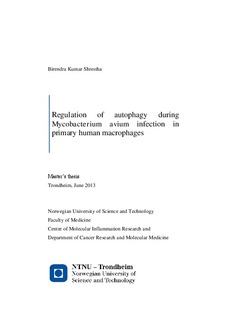| dc.description.abstract | The main aim of this project was to study the induction and regulation of autophagy during Mycobacterium avium infection in primary human macrophages. Specifically, we wanted to elucidate the role of Toll-like receptors (TLRs) 2, TLR9 and Stimulator of interferon gene (STING) in induction of autophagy during M. avium infection, and to define if oxidative stress sensor, Kelch-like ECH-associated protein 1 (KEAP1) plays a role in regulation of autophagy.
We first established an immunofluorescence autophagy assay for quantifying endogenous LC3 II punctate in primary human macrophages using confocal microscopy and an alternative human embryonic kidney cells 293 (HEK293) reporter cells assay for monitoring autophagy flux by measuring the rate of degradation of green fluorescence protein (GFP) p62.
M. avium infection induced autophagy in human macrophages as early as four hours post infection. In contrast, M. avium infection failed to induce autophagy in HEK293 cell lines even after the introduction of functional TLR2 and TLR9. Stimulation of primary human macrophages with mycobacterial lipomannan (TLR2 ligand) or cyclic diguanylate monophosphate, cyclic-di-GMP (STING ligand) induced autophagy whereas deoxycytidine-deoxyguanosine oligodinucleotide, CpG ODN (TLR9 ligand) did not. Neutralization of TLR2 with TLR2 antibodies resulted in reduction of autophagy induced by either TLR2 ligand or M. avium infection. In addition, the level of autophagy was also reduced in TLR2 knockdown macrophages during M. avium infection, but no reduction was observed with TLR9 and STING knockdown. Thus, the results suggest that TLR2, but not TLR9 or STING, is involved in M. avium induced autophagy in primary human macrophages. IV
Unpublished results from our lab suggest a role for Keap1 in regulation of inflammation during M. avium infection in primary human macrophages. Keap1 has many interaction partners, including the autophagy receptor p62. In the present study, we found that Keap1 knockdown in macrophages resulted in increased levels of autophagy and decreased survival of the mycobacteria. These results suggest a role of Keap1 in the regulation of autophagy in M. avium infected primary human macrophages. | nb_NO |
